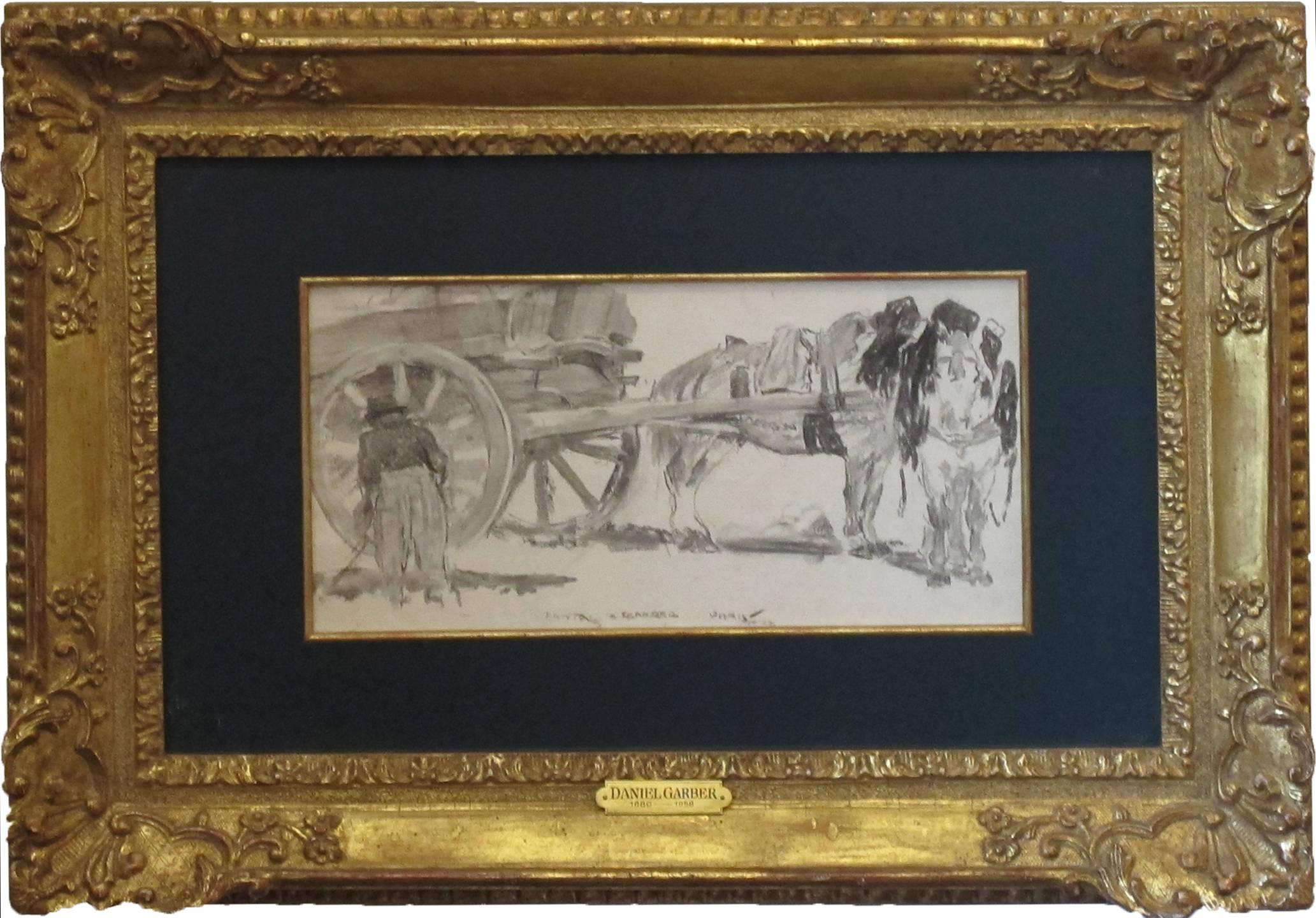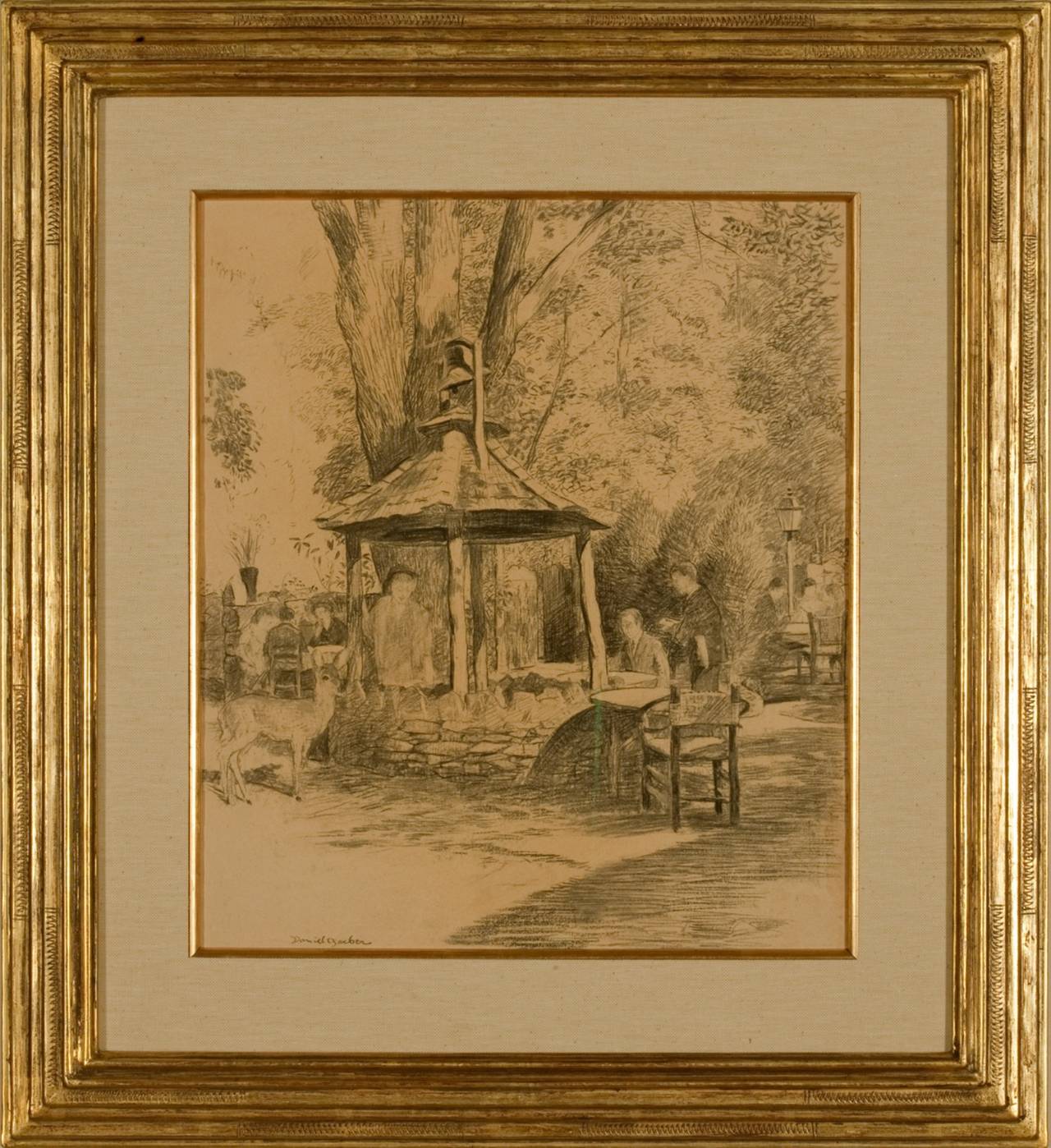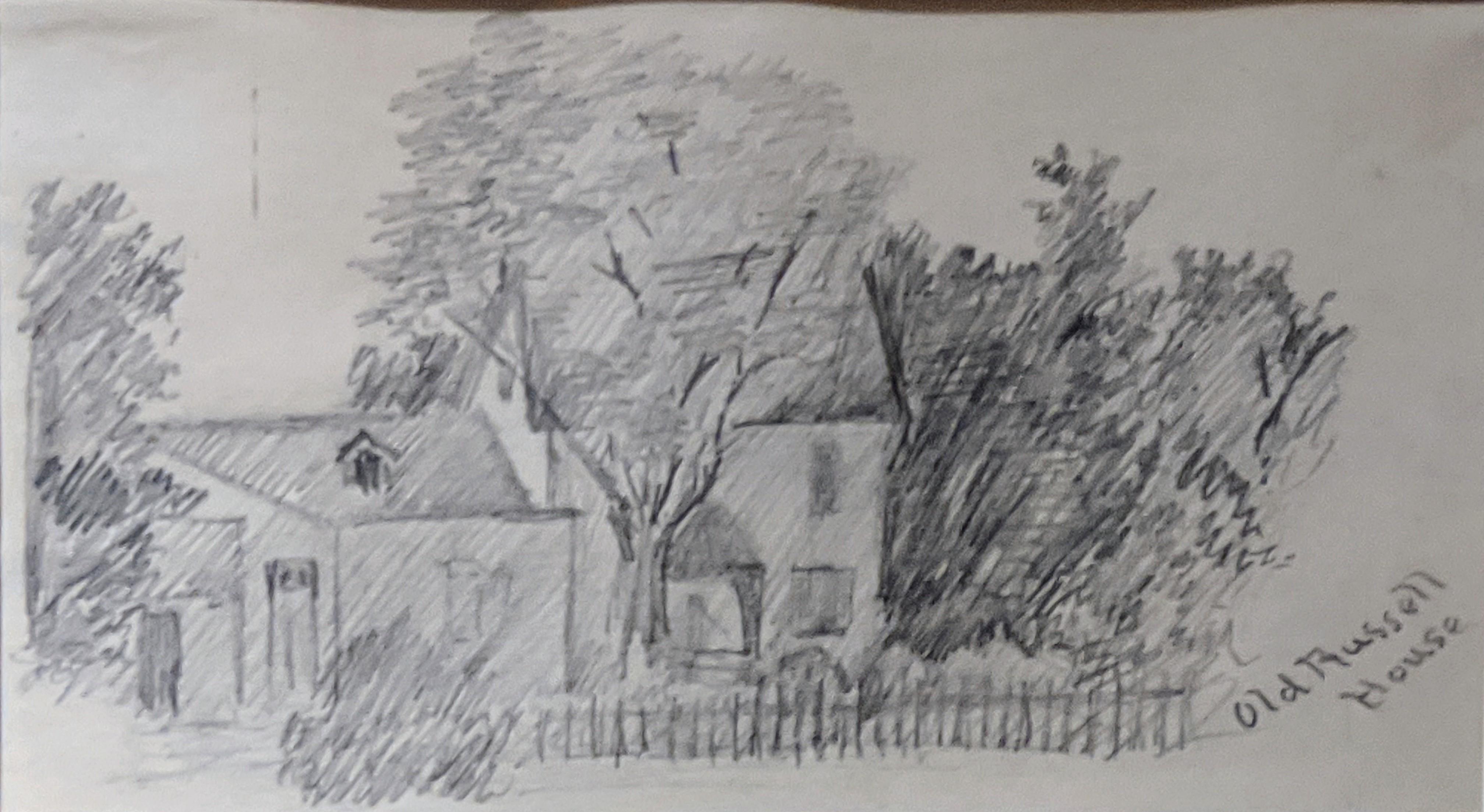George Elbert BurrMorning Near Arizona, 1880s Summer Southwestern Desert Landscape Drawing1888
1888
About the Item
- Creator:George Elbert Burr (1859 - 1939, American)
- Creation Year:1888
- Dimensions:Height: 17 in (43.18 cm)Width: 20.25 in (51.44 cm)Depth: 1 in (2.54 cm)
- Medium:
- Movement & Style:
- Period:
- Framing:Frame IncludedFraming Options Available
- Condition:very good vintage condition.
- Gallery Location:Denver, CO
- Reference Number:
George Elbert Burr
George Elbert Burr was an American printmaker and painter best known for his etchings and drypoints of the desert and mountain regions of the American West. He enjoyed success early, providing illustrations for Harper's, Scribner's Magazine, Frank Leslie's Weekly, and The Cosmopolitan. In 1892, he began a four-year project illustrating a catalog of Heber R. Bishop's collection of jade antiquities for the Metropolitan Museum of Art. This project, producing etchings of over a thousand artifacts, paid well enough for Burr to embark on an extended tour of Europe upon its completion with his wife. Over the next five years, as they traveled in Italy, Germany, and the British Isles, Burr amassed sketches and watercolors that would provide the source material for his copper plate etchings of European scenes. In 1924, the Burrs settled in Phoenix, Arizona, where he would remain for the rest of his life. The change of scenery allowed him to round out his oeuvre of Western landscapes with expansive views of the Sonoran and Mojave deserts. He and his wife, who died in 1941, are buried in Cameron. Today, George Elbert Burr is widely considered to be one of the finest of the early 20th-century American etchers. His prints are in several prominent collections including the Smithsonian American Art Museum, the British Museum, the French National Print Collection, Luxembourg Gallery, Victoria and Albert Museum, the New York Public Library, Brooklyn Museum, Museum of Northern Arizona and the Congressional Library in Washington, D.C.
- ShippingRetrieving quote...Ships From: Denver, CO
- Return PolicyA return for this item may be initiated within 7 days of delivery.
- Mountain Ranch, Modern Summer Colorado Mountain Landscape, Watercolor PaintingBy Irene D. FowlerLocated in Denver, COOriginal signed watercolor painting of a ranch in the Colorado mountains in springtime or summer coloring of green, blue, yellow, white and brown by Denver artist, Irene Fowler. Presented in a custom frame with all archival materials, outer dimensions measure 17 ½ x 23 ½ x 1 ½ inches. Image size is 12 x 18 inches. About the Artist: An important figure in the development of Denver as an artistic city, Irene Fowler was a public school teacher and founding member of the Denver Artist’s Guild (now the Colorado Artist’s Guild) in addition to being a prolific artist. She exhibited in Denver at the Schlier Gallery (where she had a solo exhibition), at the Chappell House, the University Club, and the Broadmoor Art Gallery in Colorado Springs. In 1950-1952 she served as president of the Denver Artist’s Guild. Fowler painted in oil or watercolor and her paintings were almost exclusively done en plein air. Her landscapes of Colorado...Category
Mid-20th Century American Impressionist Landscape Drawings and Watercolors
MaterialsWatercolor
- Colorado Ranch Summer Landscape Painting, 1940s Landscape WatercolorBy Irene D. FowlerLocated in Denver, COOriginal western landscape painting of trees near a ranch in Colorado by Irene Fowler, one of Colorado's preeminent women artists of the 20th century. Presented in a custom frame, outer dimensions measure 17 ½ x 23 ½ x 1 ½ inches. Image size is 11 ½ x 17 ¼ inches. Painting is clean and in very good vintage condition - please contact us for a detailed condition report. Expedited and international shipping is available - please contact us for a quote. About the Artist: An important figure in the development of Denver as an artistic city, Irene Fowler was a public school teacher and founding member of the Denver Artist’s Guild (now the Colorado Artist’s Guild) in addition to being a prolific artist. She exhibited in Denver at the Schlier Gallery (where she had a solo exhibition), at the Chappell House, the University Club...Category
Mid-20th Century American Impressionist Landscape Drawings and Watercolors
MaterialsWatercolor
- Sangre de Cristo Mountains, Southern Colorado Watercolor Landscape PaintingBy Alfred WandsLocated in Denver, COVintage original modernist watercolor painting of the Sangre de Cristo Mountain range in Colorado by Alfred Wands (1904-1998). A farm in th...Category
20th Century American Impressionist Landscape Paintings
MaterialsWatercolor
- California Coast Landscape Marine Painting, Watercolor Painting Rocks, WavesBy Charles Partridge AdamsLocated in Denver, COCalifornia coastal painting by early 20th century artist, Charles Partridge Adams circa 1925. Watercolor on paper, not signed, attributed ...Category
1920s American Impressionist Landscape Paintings
MaterialsWatercolor
- Silver Plume, Colorado, Framed Colorado Mountain Landscape Oil Pastel DrawingBy Elsie Haddon HaynesLocated in Denver, COSilver Plume, Colorado - near Georgetown, mountain landscape with fall colors, Aspen and Pine trees, river, houses and mountains by early 20th century Co...Category
1930s American Impressionist Landscape Drawings and Watercolors
MaterialsOil Pastel, Pastel
- Vintage Colorado Mountain Landscape, Original Framed Modernist Graphite DrawingBy Boardman RobinsonLocated in Denver, COOriginal graphite on paper drawing by Boardman Robinson depicting a Colorado mountain landscape. Signed by the artist lower right with an ...Category
20th Century American Modern Landscape Drawings and Watercolors
MaterialsPaper, Graphite
- "Horse Cart"By Daniel GarberLocated in Lambertville, NJJim’s of Lambertville Fine Art Gallery is proud to present this piece by Daniel Garber (1880 - 1958). One of the two most important and, so far, the most valuable of the New Hope Sc...Category
Early 20th Century American Impressionist Landscape Drawings and Waterco...
MaterialsGraphite, Paper
- "Lunch at the Stockton Inn"By Daniel GarberLocated in Lambertville, NJJim’s of Lambertville is proud to offer this artwork. Signed lower left. Pencil drawing. Complemented by a hand carved and gilt frame. Daniel Garber (1880-1958) ...Category
20th Century American Impressionist Landscape Drawings and Watercolors
MaterialsPaper, Pencil
- "Central Park"By William Langson LathropLocated in Lambertville, NJJim’s of Lambertville is proud to offer this artwork. Signed. Complemented by a hand carved and gilt frame. William L. Lathrop (1859-1938) Deemed “Father of the New Hope Art Colony”, William Langson Lathrop was born in Warren, Illinois. He was largely self-taught, having only studied briefly with William Merritt Chase in 1887, at the Art Students League. Lathrop first moved east in the early 1880s, and took a job at the Photoengraving Company in New York City. While there, he befriended a fellow employee, Henry B. Snell. The two men became lifelong friends and ultimately, both would be considered central figures among the New Hope Art Colony. Lathrop's early years as an artist were ones of continuing struggle. His efforts to break through in the New York art scene seemed futile, so he scraped enough money together to travel to Europe with Henry Snell in1888. There he met and married an English girl, Annie Burt. Upon returning to New York, he tried his hand at etching, making tools from old saw blades. Even though his prints were extremely beautiful, he still was impoverished. Lathrop would return to his family in Ohio, before once again attempting the New York art scene. In 1899, with great trepidation, he submitted five small watercolors to an exhibit at the New York Watercolor Club. He won the Evans Prize, the only award given, and four of the five paintings were sold the opening night. At age forty Lathrop’s career would finally take off and he became an “overnight success Lathrop came to Phillips Mill for the first time in1898, to visit his boyhood friend, Dr. George Marshall. Shortly after, he and his family purchased the old miller’s house from Dr. Marshall. The Lathrop’s home became a social and artistic center for the growing New Hope colony. Tea and fascinating conversation was the “order of the day” every Sunday. This was a scene fondly recalled by many younger art students that Lathrop taught privately at Phillips Mill. It was common to see groups of his students painting and sketching along the banks of the canal or aboard his canal boat. He had previously taught in the Poconos and at the Lyme, Connecticut Summer School in1907, but Phillips Mill always remained Lathrop’s permanent address. In 1928, a committee headed by Lathrop was formed to purchase the old Phillips Mill building as a place to hold community gatherings and art exhibitions. The committee had success and in 1929 the Phillips Mill Community Association was formed. This became the center of the New Hope Art Colony holding annual exhibitions and still operating today. In 1930, Lathrop had built a sailboat he named the “Widge”. For eight consecutive seasons he sailed it along the coast of Long Island...Category
Early 20th Century American Impressionist Landscape Drawings and Waterco...
MaterialsGraphite, Paper
- Vintage Landscape -- Cloister, Salisbury CathedralBy Barbara GibsonLocated in Soquel, CAWatercolor of the cloister at Salisbury Cathedral, England, by Barbara Gibson (20th Century). Painting is signed and dated by the artist "Barbara G...Category
Late 20th Century American Impressionist Landscape Drawings and Watercolors
MaterialsPencil, Paper, Watercolor
- "Old Russell House, " Charles Marion Russell, Western American DrawingBy Charles Marion RussellLocated in New York, NYCharles Marion Russell (1864 - 1926) Old Russell House Pencil on paper 3 1/2 x 6 1/2 inches Provenance: Kennedy Galleries, New York Raydon Galleries, ...Category
Late 19th Century American Impressionist Landscape Drawings and Watercolors
MaterialsPencil, Paper
- Building Under Renovation, Mid-Century Landscape Watercolor (unfinished work)By Joseph YeagerLocated in Soquel, CADetailed depiction of a building undergoing renovations by Joseph Yeager (American, 20th Century). Unsigned, but was acquired with a collection of Yeager work directly from the estate. This piece is on heavy bond paper with ragged edges, and is partially unfinished. No frame. Joseph "Joe" Yeager (American, 20th Century) was raised in Cleveland Ohio, where he went to art school at night and started his art career at 19. He was a commercial artist for the Cleveland Press...Category
Mid-20th Century American Impressionist Landscape Drawings and Watercolors
MaterialsPaper, Watercolor, Pencil






